
The Final Solution or the Final Solution to the Jewish Question was a Nazi plan for the genocide of individuals they defined as Jews during World War II. The "Final Solution to the Jewish question" was the official code name for the murder of all Jews within reach, which was not restricted to the European continent. This policy of deliberate and systematic genocide starting across German-occupied Europe was formulated in procedural and geopolitical terms by Nazi leadership in January 1942 at the Wannsee Conference held near Berlin, and culminated in the Holocaust, which saw the murder of 90% of Polish Jews, and two-thirds of the Jewish population of Europe.

Organisation Todt was a civil and military engineering organisation in Nazi Germany from 1933 to 1945, named for its founder, Fritz Todt, an engineer and senior member of the Nazi Party. The organisation was responsible for a huge range of engineering projects both in Nazi Germany and in occupied territories from France to the Soviet Union during the Second World War. The organisation became notorious for using forced labour. From 1943 until 1945 during the late phase of the Third Reich, OT administered all constructions of concentration camps to supply forced labour to industry.
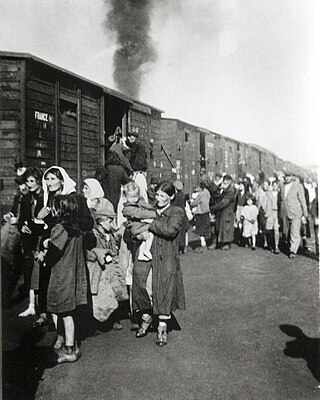
Operation Reinhard or Operation Reinhardt was the codename of the secret German plan in World War II to exterminate Polish Jews in the General Government district of German-occupied Poland. This deadliest phase of the Holocaust was marked by the introduction of extermination camps. The operation proceeded from March 1942 to November 1943; about 1.47 million or more Jews were murdered in just 100 days from late July to early November 1942, a rate which is approximately 83% higher than the commonly suggested figure for the kill rate in the Rwandan genocide. In the time frame of July to October 1942, the overall death toll, including all killings of Jews and not just Operation Reinhard, amounted to two million killed in those four months alone.
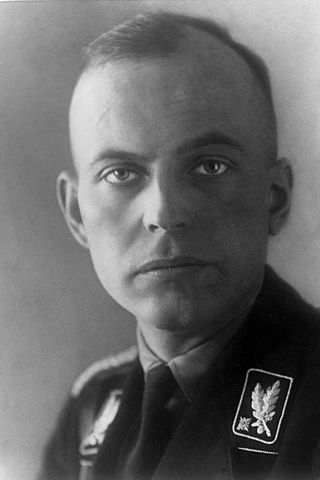
Hans-Adolf Prützmann was among the highest-ranking German SS officials during the Nazi era. From June 1941 to September 1944, he served as a Higher SS and Police Leader in the occupied Soviet Union, and from November 1943 was the Supreme SS and Police Leader in Ukraine. He oversaw the activities of the Einsatzgruppen detachments that perpetrated the Holocaust in the Baltic States and Ukraine. After being captured at the end of the Second World War, he committed suicide.
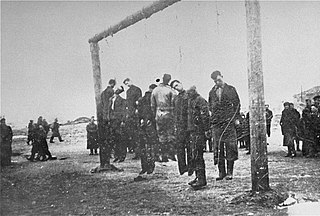
The Lwów Ghetto was a Nazi ghetto in the city of Lwów in the territory of Nazi-administered General Government in German-occupied Poland.

The Schutzmannschaft, or Auxiliary Police was the collaborationist auxiliary police of native policemen serving in those areas of the Soviet Union and the Baltic states occupied by Nazi Germany during World War II. Heinrich Himmler, head of the SS, established the Schutzmannschaft on 25 July 1941, and subordinated it to the Order Police. By the end of 1941, some 45,000 men served in Schutzmannschaft units, about half of them in the battalions. During 1942, Schutzmannschaften expanded to an estimated 300,000 men, with battalions accounting for about a third, or less than one half of the local force. Everywhere, local police far outnumbered the equivalent German personnel several times; in most places, the ratio of Germans to natives was about 1-to-10.

Fritz Katzmann, also known as Friedrich Katzmann, was a German SS and Police Leader during the Nazi era. He perpetrated genocide in the cities of Kattowitz, Radom, Lemberg, Danzig, and across the Nazi occupied District of Galicia in the General Government during the Holocaust in Poland, making him a major figure during the Holocaust there.

Baron Otto Gustav von Wächter was an Austrian lawyer, Nazi politician and a high-ranking member of the SS, a paramilitary organisation of the Nazi Party. He participated in the Final Solution extermination of Jews in Europe, and was instrumental in creating an SS division consisting of Ukrainians.

Kraków District was one of the original four administrative districts set up by Nazi Germany after the German occupation of Poland during the years of 1939–1945. This district, along with the other three districts, formed the General Government. It was established on October 12, 1939 by Adolf Hitler, with the capital in occupied Kraków – the historic residence of Polish royalty. The Nazi Gauleiter Hans Frank became the Governor-General of the entire territory of the General Government. He made his residence in Kraków at the heavily guarded Wawel castle. Frank was the former legal counsel to the Nazi Party.

Janowska concentration camp was a German Nazi concentration camp combining elements of labor, transit, and extermination camps. It was established in September 1941 on the outskirts of Lwów in what had become, after the German invasion, the General Government. The camp was named after the nearby street Janowska in Lwów of the interwar Second Polish Republic.

The Trawniki concentration camp was set up by Nazi Germany in the village of Trawniki about 40 kilometres (25 mi) southeast of Lublin during the occupation of Poland in World War II. Throughout its existence the camp served a dual function. It was organized on the grounds of the former Polish sugar refinery of the Central Industrial Region, and subdivided into at least three distinct zones.
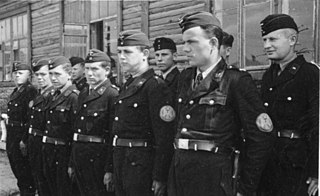
The Ukrainian Auxiliary Police was the official title of the local police formation set up by Nazi Germany during World War II in Eastern Galicia and Reichskommissariat Ukraine, shortly after the German occupation of the Western Ukrainian SSR in Operation Barbarossa.

The Radom Ghetto was a Nazi ghetto set up in March 1941 in the city of Radom during the Nazi occupation of Poland, for the purpose of persecution and exploitation of Polish Jews. It was closed off from the outside officially in April 1941. A year and a half later, the liquidation of the ghetto began in August 1942, and ended in July 1944, with approximately 30,000–32,000 victims deported aboard Holocaust trains to their deaths at the Treblinka extermination camp.
The Šiauliai or Shavli Ghetto was a Jewish ghetto established in July 1941 by Nazi Germany in the city of Šiauliai in Nazi-occupied Lithuania during the Holocaust. The ghetto comprised two areas – one in the Kaukazas suburb and one on Trakai Street. Both were liquidated by July 1944, and their inhabitants were killed or transferred to Nazi concentration camps. In 1939, one quarter of the population of Šiauliai was Jewish, about 8,000 persons. By the end of World War II, only about 500 Jews of the city had survived.
Poniatowa concentration camp in the town of Poniatowa in occupied Poland, 36 kilometres (22 mi) west of Lublin, was established by the SS in the latter half of 1941, initially to hold Soviet prisoners of war following Operation Barbarossa. By mid-1942, about 20,000 Soviet POWs had perished there from hunger, disease and executions. The camp was known at that time as the Stalag 359 Poniatowa. Afterwards, the Stammlager was redesigned and expanded as a concentration camp to provide slave labour supporting the German war effort, with workshops run by the SS Ostindustrie (Osti) on the grounds of the prewar Polish telecommunications equipment factory founded in the late 1930s. Poniatowa became part of the Majdanek concentration camp system of subcamps in the early autumn of 1943. The wholesale massacre of its mostly Jewish workforce took place during the Aktion Erntefest, thus concluding the Operation Reinhard in General Government.
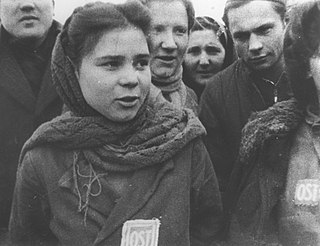
Ostindustrie GmbH was one of many industrial projects set up by the Nazi German Schutzstaffel (SS) using Jewish and Polish forced labor during World War II. Founded in March 1943 in German-occupied Poland, Osti operated confiscated Jewish and Polish prewar industrial enterprises, including foundries, textile plants, quarries and glassworks. Osti was headed by SS-Obersturmführer Max Horn, who was subordinated directly to Obergruppenführer Oswald Pohl of the SS Main Economic and Administrative Office. At its height, some 16,000 Jews and 1,000 Poles worked for the company, interned in a network of labor and concentration camps in the Lublin District of the semi-colonial General Government territory.
German Equipment Works was a Nazi German defense contractor with headquarters in Berlin during World War II, owned and operated by the Schutzstaffel (SS). It consisted of a network of requisitioned factories and camp workshops across German-occupied Europe exploiting the prisoner slave labour from Nazi concentration camps and the Jewish ghettos in German-occupied Poland. DAW outfitted the German military with boots, uniforms and materials on the eastern front at a windfall profit, and provided wood and metal supplies, as well as reconstruction work on railway lines and freight trains.

SS-Truppenübungsplatz Heidelager was a World War II SS military complex and Nazi concentration camp in Pustków and Pustków Osiedle, Occupied Poland. The Nazi facility was built to train collaborationist military units, including the Ukrainian 14th Waffen SS Division "Galician", and units from Estonia. This training included killing operations inside the concentration camps – most notably at the nearby Pustków and Szebnie camps – and Jewish ghettos in the vicinity of the 'Heidelager'. The military area was situated in the triangle of the Wisła and San rivers, dominated by large forest areas. The centre of the Heidelager was at Blizna, the location of the secret Nazi V-2 missile launch site, which was built and staffed by prisoners from the concentration camp at Pustków.
Budzyń concentration camp was a forced labor and concentration camp built and operated by the SS of Nazi Germany between the Spring of 1942 and June/July 1944. It was located in the industrial district of Kraśnik, Poland, in the Lublin District of the General Government territory of German-occupied Poland. Budzyń began as a sub-camp of the Majdanek concentration camp, but became an independent concentration camp in October 1943 after the deportation of over 1,000 Jews after the Warsaw Ghetto Uprising.

Willi Ahrem was a German man who saved Jewish people during World War II. As a commander, he managed a forced-labor camp Arbeitslager operated by the Todt organization in Nemyriv, Ukraine during World War II. At that time, Ukraine was part of the Union of Soviet Socialist Republics (USSR), until it was occupied by the Germans.
















